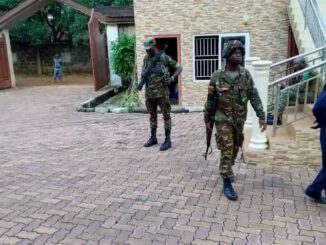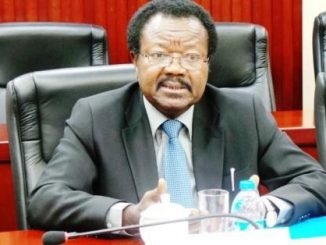
THE SECRET AND GAME PLAN OF THE MIDTERM CENSUS
By Sylvanus Fornah Koroma Jr. (What A Man!)
The deceitful Statistician General of Statistics-Sierra Leone (SSL or Stats-SL) has the propensity to bring unrest in Sierra Leone if the government does not guide against this man’s falsity.
Just a few days ago, someone in Kenema issued threats of violence on social media that has gone viral. The message was a threat of violence against Northerners residing in Kenema that stand with and are in support of the All People’s Congress (APC) position of non-participation of its members and supporters in the controversial and unprecedented midterm electronic census. But on a special piece, those issues of threats and acts of violence would be addressed. For now, the focus is on the deceitful Statistician General Professor Mallam O Sankoh (the boy from Warima as he often describes himself). This professor only cares about himself and things attached to his name. He is proud to say he changed Statistics Sierra Leone (SSL) to Stats-SL, District Census Officer to District Census Coordinator, removed Field Officers from the structure of supervising the census and condensed the four levels of census training to two. But these are legalities that we will save for an appropriate time.

Meanwhile let us focus on the analysis of the table above, labelled as Table 1 which exposes the reasons for the mad rush for an unprecedented mid-term census that has been condemned both locally and internationally including the European Union and The World Bank.
Table 1 is a comparative analysis of Enumeration Areas (EAs), Households and Estimated Population from 2021 Midterm Census Cartographic Mapping and the actual EAs, Household and Population of 2015 Census by district in Sierra Leone. In just six years, the population nearly doubles. This is not possible and therefore Stats-SL should explain how they arrived at this unprecedented growth. Take a glance at the difference in the number of EAs in 2015 and those in 2021. In the Eastern Region the number of EAs increased from 2797 in 2015 to 6053 in 2021. Making and addition of 3256 which is 116.4% increase in 6 years. It must be noted that Kono only has 586 of the 3256 EAs. In other words, Kenema and Kailahun have increased their EAs by 2670.
Whereas the Northern Region has increased its EAs from 2519 in 2015 to 3889 in 2021 which is 54.4% increase in 6 years. In other words, 1370 EAs have been added to this region since 2015. This means that Kenema alone which has 1721 EAs has 351 more EAs than the whole of the Northern Province (i.e., Bombali, Falaba, Koinadugu and Tonkolili).
Whereas the North-Western Region has increased its EAs from 2011 in 2015 to 3156 which is 56.9% increase in 6 years. The number of additional EAs in this region is 1145. Again, the number of increased EAs in Kenema district alone surpasses the whole of the North-Western Region by 576 EAs.
Whereas the number of EAs in the Southern Region has increased from 2690 in 2015 to 5530 in 2021 which is 105.6% increase in 6 years. This means that the EAs have increased by 2840. In other words, the number of increased EAs in just the Southern Region is 325 more than both the regions of North and North-West combined. In Pujehun district alone, they have 944 EAs whereas the whole of North-West Region has 1145 EAs which is a difference of 201 EAs between the districts and the whole region.
Whereas the Western Area has increased its EAs from 2839 in 2015 to 5106 in 2021 which is 79.9% increase in 6 years. The number of additional EAs is 2267. Bo district has more additional EAs than Western Urban and Kenema has more additional EAs than Western Rural. In a nutshell, the South and Eastern Regions have 1314 more additional EAs than the North, North-Western Region and the Western Area combined.
The Household is generally defined for the purposes of census to mean ‘all the people who occupy single housing unit regardless of their relationship to one another. Family households have a householder and one or more additional people who are related to the householder by marriage, birth, adoption or employment. A Housing Census is the official enumeration of all living quarters (occupied and vacant) in a country at a specified time.
Whereas the Eastern Region number of household mappings increased from 295,035 households in 2015 to 561,952households in 2021, there is a total increase of 266,917 households which is 90.5% increase in 6 years.
Whereas the Northern Region number of household mapping increased from 234,072 in 2015 to 379,558 in 2021. There is a total increase of 145,486 households which is 62.2% increase in 6 years. This means that the whole of Northern Region only has 9003 more households than Kenema as a district. Again,the Eastern Region has 121,431 more households than the Northern Region.
Whereas the North-Western Region number of households mapping increased from 212,960 in 2015 to 300,258 in 2021. There is a total increase of 87,928 households which is 41.0% increase in 6 years. This means that the Eastern Region alone has 34,133 more households than the North and North-Western Region combined. In fact, even Kailahun alone has 1599 more households than the whole of the North-Western Region.
Whereas the Southern Region household mapping increased from 271,016 households in 2015 to 511,097 households in 2021. There is a total increase of 240,081households which is 86.6% increase in 6 years. Again, the number of increased household mappings of the Southern Region surpasses both the Northern and North-Western Regions combined by 7297household. In fact, the difference of households in Pujehun (85328), the whole of North-Western Region (87298) is 1970 households.
Whereas the Western Area number of household mapping increased from 334,148 households in 2015 to 496,146households in 2021. There is a total increase of 161,998 households which is 48.5% increase in 6 years. Kenema only has 25,515 households less than the whole of Western Area. In a nutshell, the South and Eastern Regions have 112,216 more households than the North, North-Western Regions and Western Area combined.
A population census is the official enumeration of all persons in a country at a specified time. An estimated population is developed from the pilot census and the cartographic mapping done. We will hereby do an analysis of the Actual Population in 2015 Census and the Estimate Population from the 2021 mapping.
Whereas the Eastern Region actual population was 1,642,370persons in the 2015 Census, it is now estimated at 3,371,712persons in 2021. There is a total increase of 1,729,342 persons which is 105.3% increase in 6 years.
Whereas, the Northern Region actual population was 1,346,316 persons in the 2015 Census, it is now estimated at 2,227,348 persons in 2021. There is a total increase of 931,032 persons which is 69.2% increase in 6 years. The estimated increased population of Kenema district alone has a much-expected added population in 2021 as the whole of the Northern Region with just 16,791 persons difference.
Whereas the North-Western Region actual population was 1,161,885 persons in 2015 census, it is now estimated at 1,801,548 persons in 2021. There is total increase of 639,663persons which is 55.1% increase in 6 years. This means that the Eastern Region is estimated to have 105,647 more persons than the combined regions of the North and Northwest.
Whereas the Southern Region actual population in the 2015 Census was 1,441,308 persons, it is now estimated in 2021 at 3,066,582 persons. There is a total increase of 1,625,274persons which is 112.8% increase in 6 years. Again, the sum total of the estimated added figure in the Southern Region surpasses the joint number of persons in both the combined regions of the North and North-West by 1,570,695.
Whereas the Western Area actual population in the 2015 census was 1,500,234 persons, it is now estimated in 2021 at 2,976,876 persons. There is a total increase of 1,476,642 person. Which is 98.4% increase in 6 years. In a nutshell, the South and Eastern Regions have 307,279 more estimated added persons than the people in the North, Nort-Western Region and Western Area combined.
Stats-SL has recently commented about its published results of the unpopular Midterm Pilot Census and Cartographic Mapping result on its website; when at about the same time the World Bank had written its famous Midterm Census letter addressed to both Mr Dennis K. Vandi, the Minister of Finance and Dr. Francis Kaikai, the Minister of Economic and Development Planning, the Chief Minister, the Statistician General and the Executive Director, The World Bank were copied.
The World Bank did not only pull out of the process, but they also withdrew their financial support. The acclaimed published pilot census was not evaluated before the said date for the start of enumeration on December 9, 2021. There is evidently no field operation plan and the training was haphazardly done. We are now into the second week of the controversial, problematic and unprecedented midterm census and many enumerators do not know where to work and who supervised them. Professor Mallam O Sankoh does not seem to be in charge as Chief Census Officer.
This so-called Midterm Electronic Census is a flawed process; training was collapsed from four to two levels bypassing the regional and chiefdom level training, quality control mechanism is not there as field officers were not recruited to supervise data collection at chiefdom level. Because there is no deployment plan, enumerators are not familiar with their places of work, cannot identify Enumeration Area (EA) boundaries and most of them cannot speak the language of the localities they are working in. Another challenge is that most of the enumerators cannot operate their tablets and the data collected will be lost if not saved. Worst of all, since there is a gap (due to the absence of Field Officers) enumerators deployed in the rural areas might not go there and will‘capstone’ the data (data from the top of their heads). The truth is that the boy from Warima i.e., the Chief Census Officer is not mindful about these lapses.
The issues raised by the World Bank are legitimate and should have been addressed before the start of enumeration. International Best Practice is that any issue raised by any partner, especially technical issues, should not be overlooked by the Chief Census Officer and his team. Samuel Ansumana, the Director of Communication Stats-SL reiterated the importance of expert and the technical partners on his interview on November 30, 2021, on Radio 98.1 FM, Good Morning Salone program. But yet in practice, Stats-SL is ignoring its own acclaimed belief. Going on with the census count without addressing the legitimate concerns raised by the international partners and experts is a breach of International Best Practice. This another major anomaly of the midterm electronic census!!!
The Chief Census Officer, Statistician General, Professor Mallam O Sankoh said he is the rapporteur of the UN Statistics Division. So, one would expect he followed the compendium of principles prescribed by the United Nations in conducting the census. This compendium was put together by ‘Friends of Chair’ (i.e., a technical group in the UN Statistics Division) and discussed and ratified by all member states of the UN.
Why is the professed UN rapporteur, the Statistician General, professor Mallam O Sankoh bringing in the processes that are not aligned with the principles and recommendations in conducting rounds of censuses. Well, he is the boy from Warima, a professor and maybe he is above the UN principle. The professor should know that no one stops him from innovating, but this should not be against agreed principles and law.
N.B.
Professor Mallam O Sankoh recruited 15,000 enumerators but the actual Enumeration Areas (EAs) as per the mappings are 23,734. This being the case, there are 8,734 more enumerators or otherwise some enumerators have to serve more than one Enumeration Area to cover all 23,734 EAs.
The huge discrepancy signals some amount of inefficiency and these are believed to be part of the the concerns raised by the World Bank. The lack of justification for such a huge number of EAs not been accounted for, leaves many curious minds questioning the process and thus increase the justified level of doubt on the entire process.
We need to understand or get explanation from the Statistician General and Statistics-SL to answer these questions:
1)What economic activities have taken place to cause this economic change as stated by the Pilot Census and the Cartographic Mapping within just 6 years?
2)Most of the districts in the South and East Regions grew over 100 % in all the said assessment but none of the districts in the North and North-Western Regions went even as close as 90%. The question is why is this so?
3) For obvious reasons, would anyone want to ask questions about the Western Area figures? FOOD FOR THOUGHT!!!



